Statistical analysis for particle detector RnD.
Summary
It is estimated that ~85% by mass of our universe is made up of dark-matter, a kind of matter that is fundamentally different from the kind that we and the stars and the planets are made of. WIMPs (Weakly Interacting Massive Particles) are a class of dark matter candidate particles that are highly favored from the standpoint of both cosmology and particle physics. They interact weakly with one another and do not shine, they have interaction probabilities that are in the range necessary for them to have been produced during the big-bang and remained as relics ever since. Experiments have been built to be sensitive to WIMPs recoiling off the nuclei of terrestrial detectors. SuperCDMS uses Silicon and Germanium detectors operated at ~50mK temperature and measures both phonons (lattice vibrations) and ionization that are caused by recoiling particles inside the detectors. The current generation iZIP detectors used in the experiment at Soudan are highly sophisticated and provide excellent information about the position and energy of an event (interaction) in the detector using phonon and ionization sensors on both top and bottom sides. Here we explored a modified design that can provide comparable performance while doing away with half the phonon sensors in order to reduce fabrication costs and the chance of faults.
Some background
Dark matter and direct dark matter search
Dark matter is an explanation to the gravitational and structural observations made about the universe. Mass excesses in galaxies and galaxy-clusters inferred through rotation speeds of objects around their centers and from lensing effect of luminescent objets passing with large clusters of galaxies are a couple of prominent examples of such observations. It is called “dark” matter because it does not shine or glow and hence we cannot observe it through telescopes. This has serious implication for what dark matter could be. It means that dark matter does not interact electromagnetically and is fundamentally a different the kind of matter that makes up stars and us and all the other things that do shine. WIMPs (Weakly Interacting Massive Particles) are a class of candidate particles that are highly favored the standpoint of both cosmology and particle physics. They interact weakly with one another and do not shine, they have interaction probabilities are in the range necessary to have been produced during the big-bang and to have remained as relics ever since.
Direct dark matter search is very active research area in experimental particle physics with strong competition among experiments. It attempts to detect dark matter particles from our own galaxy using terrestrial detectors. This would serve to confirm its existence as well as allow us to better understand dark-matter if it does exist. SuperCDMS is a leading experiment in this area and is collaboration of several university groups and national labs. The experiment is currently housed in the Soudan mine (at a depth of 716 meters) in northern Minnesota (US) and is set to move to SNOLAB in Sudbury (Canada) and upgrade its effort. Such an experiment is a rare event search, meaning it looks for a signal among a lot of noise (usually referred to as background). These experiments typically keep track of individual events, which are interactions of a particles inside the detector. They measure physical parameters such as energy, position, timing etc. for each such event. The background events typically come from ambient radioactivity, cosmogenic particles, intrinsic material radioactivity and other local effects. Such experiments rely heavily on reducing the background through many strategies including going deep underground, shielding, ensuring radio-purity of materials, vetoing known background events etc.. They further improve their sensitivity through clever design of detectors to eliminate significant portions of background events. They also try ascertain the expected amount and distribution of the residual background events using data and simulations. Finally through a rigorous analysis they ascertain if any candidate dark-matter particles were observed, i.e. a statistically significant excess in the data and distribution of events that is not as expected from just the background events.
SuperCDMS particle detectors
The SuperCDMS particle detectors used at Soudan are cryogenic semiconductor detectors made. They measure the energy deposited by the particles interacting in the detector through a measurement of phonons (lattice vibrations) and ionization (electric charges released). They are solid cylinders of either Germanium or Silicon with phonon and ionization sensors on the top and bottom surfaces as shown in figure.1 below. The science of these sensors is very fascinating in itself and rather involved so I would refer the interested reader to article linked here.
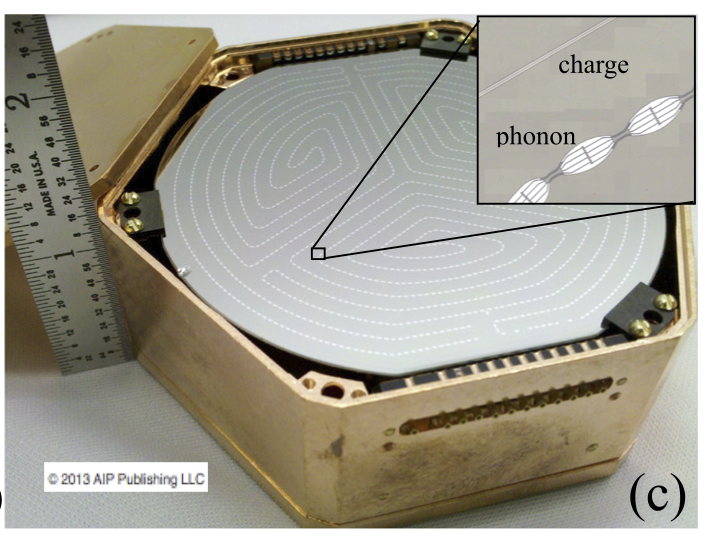 |
|---|
| Figure.1: A photo of superCDMS detector. Phonon sensors and charge sensors on the surface form an interleaved pattern Source: AIP Appl. Phys. Lett. article 2013, http://dx.doi.org/10.1063/1.4826093 |
These two signals are then used in combination to distinguish candidate dark matter particles from a major source of background events called ‘electron-recoils’. Electron-recoils are a class of events in which a large portion of the energy from interacting particle is absorbed by recoiling electrons in the detector material. In contrast, dark-matter particles and neutrons produce an interaction where the major portion of the energy deposited by the incoming particle is transferred to the nuclei in the detector material and are called ‘nuclear-recoils’. This shows up as a difference in the ratio of the energy measured in the charge (ionization) channel vs the energy measured in the phonon (lattice vibration) channel. Figure.2 shows this difference.
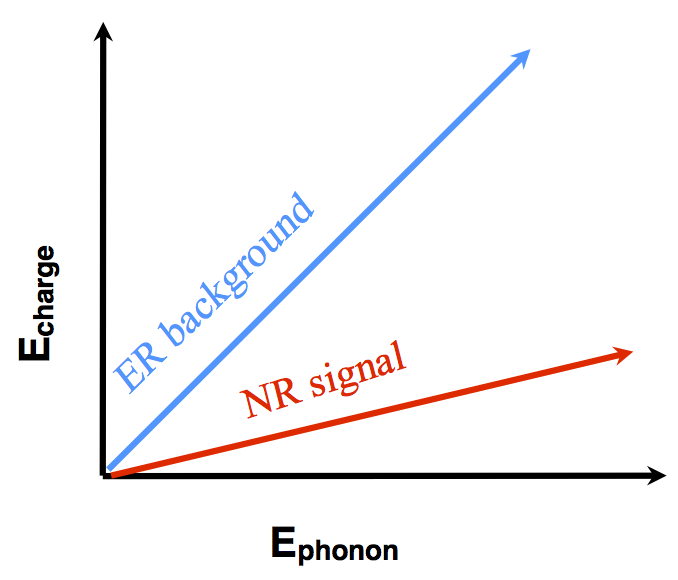 |
|---|
| Figure.2: Energy in charge (ionization) channel vs energy in phonon channel for Electron-Recoils and Nuclear-Recoils. |
This is typically illustrated in a transformed parameter space of Yeild vs recoil-energy, where recoil-energy is the true energy deposited by the incoming particle and Yield is the ratio of the ionization signal and the recoil-energy. With the use of data generated from known sources of particles for calibration we arrive at regions of Electron-Recoils and Nuclear-Recoils in this transformed parameter space. Figure.3 shows two distinct bands of events from calibration sources in this parameter space; the black dots correspond to electron-recoils and the grey dots correspond to nuclear-recoils. Despite this inherent difference in the two classes of events a portion of electron-recoil events “leak” in to signal region due to limitations detection technology. It has been ascertained that the vast majority this leakage comes from events happening close to the surface of the detector. The number of background events that leak into signal region for a defined number of “potential” background events is then a good parameter in assessing detector performance and can be termed as the “leakage rate”. The “potential” background events being electron-recoil events that happen close to the surfaces of the detector.
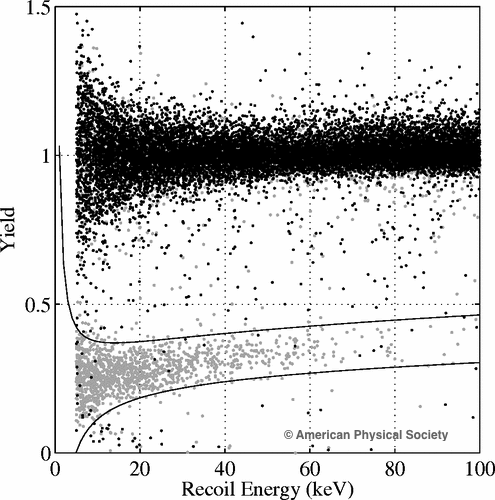 |
|---|
| Figure.3: Yield vs recoil-energy for Electron-Recoils (black) and Nuclear-Recoils (grey). Source: APS Phys. Rev. D article 2005, http://dx.doi.org/10.1103/PhysRevD.72.052009. © American Physical Society, used with permission. |
A modified detector design concept
Scaling an experiment of this kind can involve several challenges, one of them being the challenge of producing reliable detectors with good efficiency of cost and effort. The question of whether it is possible to produce a detector which could offer these benefits without affecting performance led us to a modified detector design. The modified design featured phonon sensors on a single side instead of two sides as in the case of existing iZIP detectors. This would reduce fabrication costs and effort and reduce the probability of defects per detector. If using half the number of sensors did not compromise the performance by much, this would make for a lucrative trade-off. The alternative design also offered the chance to re-configure the ionization sensors in way so as to discriminate against a special class of background events called multiple-surface-scatter events. The details of that are beyond the scope of this short article, so I would refer the interested reader to section 5.1 in my thesis.
The objective then was to compare performance of this alternative design with the existing.This involved two phases. The first phase involved establishing proof of principle through analysis of existing data and analytic calculations. The second phase involved configuring a detector in the alternative design and validating the results of the first phase through independent measurements (i.e. new data). The second phase also allowed testing a alternative configuration of ionization sensors for the detection of multiple-surface-scatter events.
PHASE 1: Proof of principle
The feasibility of the design was tested by comparing the performance of the alternative and the existing design . The key performance metric for comparison being the “leakage rate” which largely determines the sensitivity of the experiment. Ideally of course, the goal would be to have a “0-background” experiment. By comparing the leakage rates we could check the feasibility of the new design without having to produce a detector with the modified design first.
Using only half the information available mean’t that we had to come up with new estimators for physical quantities that were hitherto calculated using full information. This also meant that all the data cleaning and preparation had also to be re-done using only half the information. Figure.4 shows the yield vs recoil energy for the existing iZIP design with phonon sensors on both sides for some data taken on a test facility on the surface of the earth. The dataset contains events that happen close to the surface of the detector and are likely to leak into the signal region, hence making such a dataset very useful for assessing the performance in terms of leakage rate.
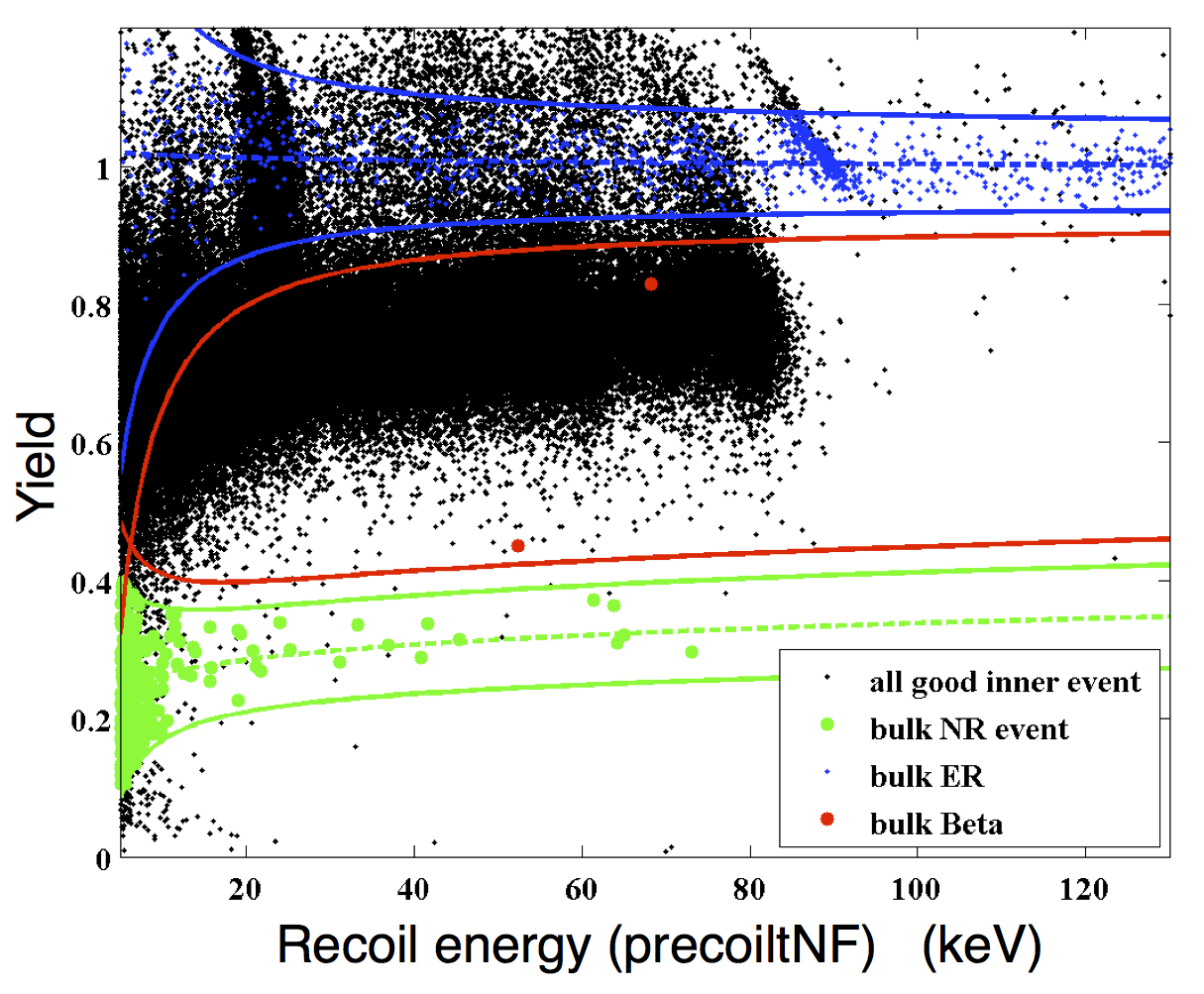 |
|---|
| Figure.4: Yield vs recoil-energy for a dataset with large number of electron-recoil events that happen close to the surface of the detector which are likely to leak into signal region due to reduced charge collection. Calibration data is used to define signal region (light green lines) and the electron recoil band (blue lines). These lines are 95% confidence interval or \( 2\sigma \) lines. The red lines are the bottom and upper \( 3\sigma \) lines for the blue and the light green bands respectively. Primary source: Y.Ricci et al. SuperCDMS internal notes. Secondary source: Kedar Page MSc thesis, 2013. |
After re-defining quantities in terms of information available from sensors on a single side, the same analysis was carried out for different possible configurations. It was found that no new background events were added in any of these configurations.
PHASE 2: Validation
A detector was then configured according to the modified design and similar surface events data was acquired. Figure.5 shows the Yeild vs recoil energy for this new data after a similar analysis.
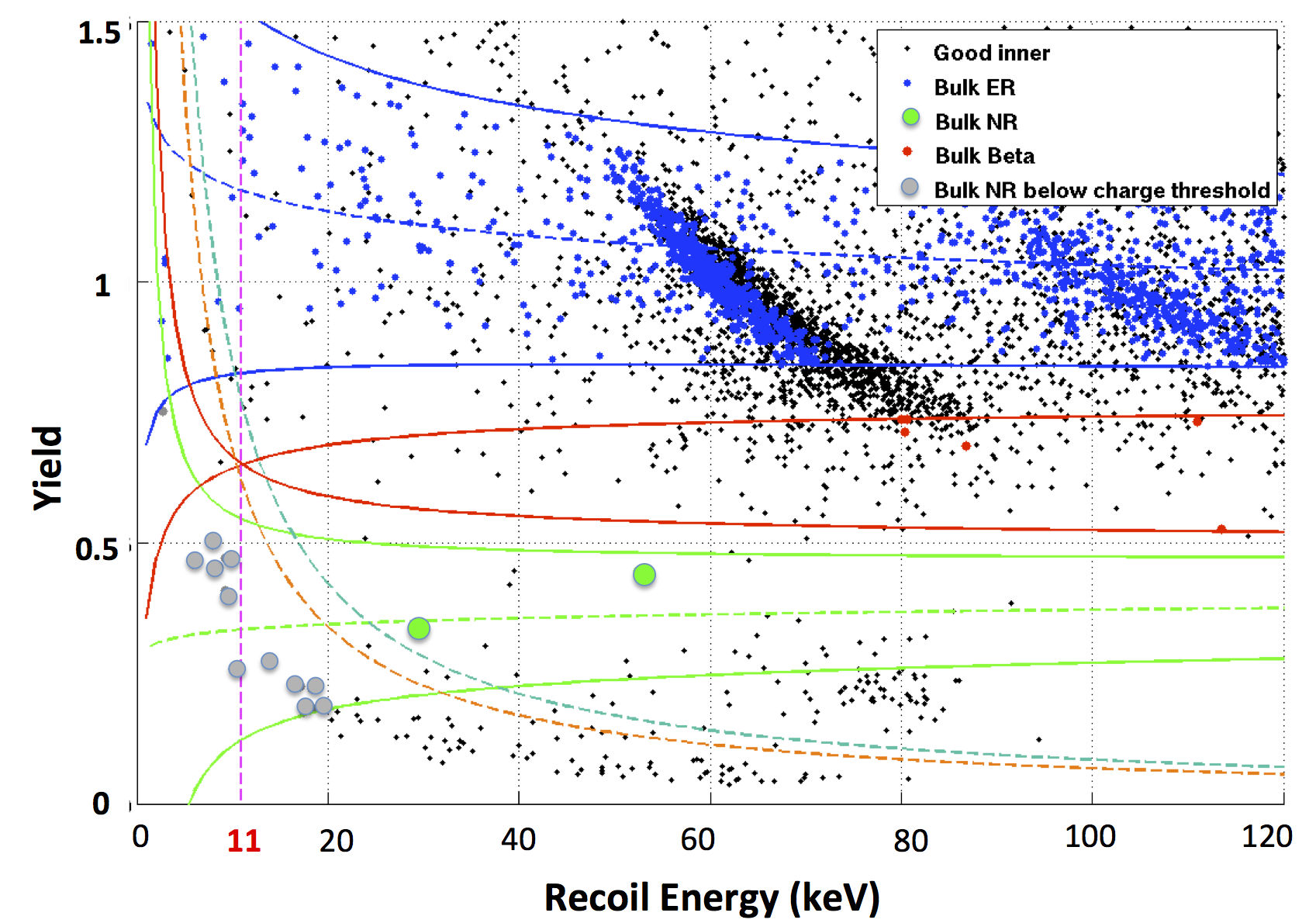 |
|---|
| Figure.5: Yield vs recoil-energy for the new data from the modified design. The light green, the blue and the red lines have same definitions as in figure.4. The dashed turquoise line is the lower threshold for the analysis. Two events marked as big green dots are seen in the signal region above the threshold and pass all other background discrimination methods. Source: Kedar Page MSc thesis, 2013. |
Figure.6 shows the Yield vs recoil energy for the original data from phase 1 which has the same configuration as the modified design i.e. using information from sensors on the side and with the same rest of the parameters.
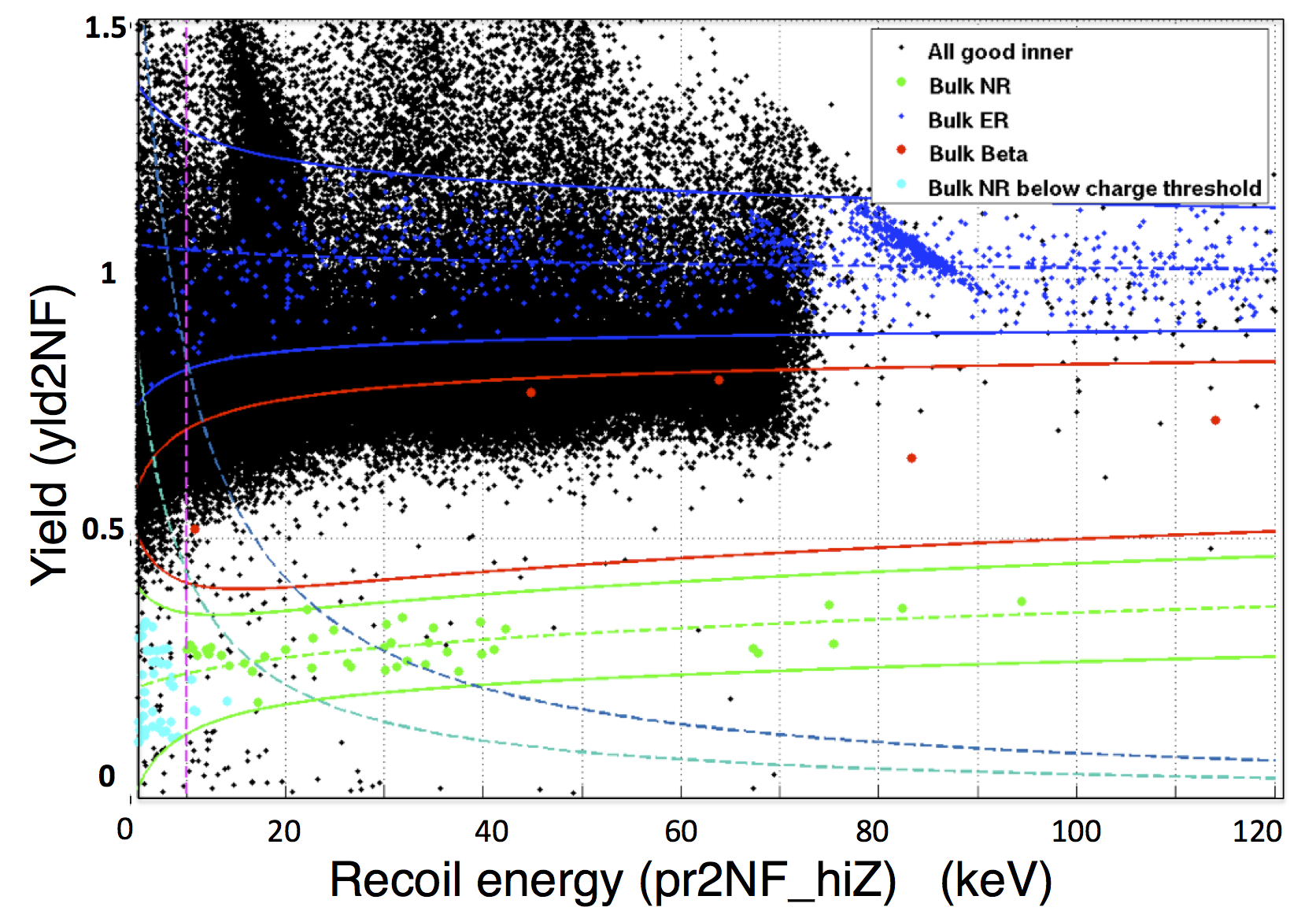 |
|---|
| Figure.6: Yield vs recoil-energy for the original data set from phase 1 in the same configuration as the new data from phase 2. The light green, the blue and the red lines have same definitions as in figure.4. The dashed royal-blue line indicating the analysis threshold used for new data (i.e. same as the dashed turquoise line in figure.5) : Kedar Page MSc thesis, 2013. |
Although just looking at the figure.6 and comparing with figure.5 it may appear that the leakage rate is much higher in the original configuration (figure.6), they are in fact statistically compatible since the new data sample (figure.5) had fewer events to begin with. This along with the resuslts from phase 1 confirmed that we could indeed build a detector with this modified design and expect to gain comparable performance while significantly cutting down the fabrication costs and the amount of data.
This project was carried out at Queen’s University along with members of the SuperCDMS research group at Queen’s and formed a major portion of my thesis project for MSc in Physics. Linked here is the full text of the thesis. This project was part of a larger detector R&D effort at the SuperCDMS collaboration targeted towards a bigger version of the experiment in future.